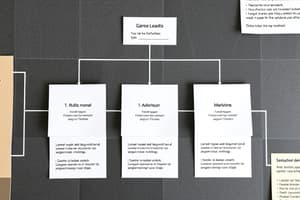Podcast
Questions and Answers
Which phase of the ADDIE model involves evaluating the effectiveness of the training program and informing future iterations?
Which phase of the ADDIE model involves evaluating the effectiveness of the training program and informing future iterations?
- Development
- Design
- Evaluation (correct)
- Analysis
According to Bloom's Taxonomy, which cognitive level involves breaking down information into parts and recognizing patterns?
According to Bloom's Taxonomy, which cognitive level involves breaking down information into parts and recognizing patterns?
- Understanding
- Analyzing (correct)
- Remembering
- Applying
Which of the following is NOT a factor to consider when reviewing storyboards in the eLearning development process?
Which of the following is NOT a factor to consider when reviewing storyboards in the eLearning development process?
- Engaging interactivity
- Comprehensive content inclusion
- Budgetary constraints (correct)
- Alignment with learning objectives
During the implementation phase of the ADDIE model, which strategy can be used to measure knowledge gain?
During the implementation phase of the ADDIE model, which strategy can be used to measure knowledge gain?
Which cognitive level in Bloom's Taxonomy involves putting parts together to form a new coherent whole or creating an original product?
Which cognitive level in Bloom's Taxonomy involves putting parts together to form a new coherent whole or creating an original product?
What is the primary purpose of storyboarding in the eLearning development process?
What is the primary purpose of storyboarding in the eLearning development process?
Which phase of the ADDIE model involves conducting a needs analysis and assessing learners' prior knowledge?
Which phase of the ADDIE model involves conducting a needs analysis and assessing learners' prior knowledge?
During the Design phase, which taxonomic framework is often used to ensure content aligns with desired cognitive outcomes?
During the Design phase, which taxonomic framework is often used to ensure content aligns with desired cognitive outcomes?
Which of the following is not a typical activity during the Development phase of the ADDIE model?
Which of the following is not a typical activity during the Development phase of the ADDIE model?
In the context of instructional design, what is the primary purpose of storyboarding?
In the context of instructional design, what is the primary purpose of storyboarding?
Which instructional design strategy is least likely to promote effective learning outcomes?
Which instructional design strategy is least likely to promote effective learning outcomes?
According to Bloom's Taxonomy, which cognitive level represents the highest order of thinking skills?
According to Bloom's Taxonomy, which cognitive level represents the highest order of thinking skills?
Flashcards are hidden until you start studying
Study Notes
Instructional Design Strategies
I. ADDIE Model
The ADDIE model, a staple in instructional design, stands for Analysis, Design, Development, Implementation, and Evaluation. This systematic methodology provides a framework for designing, developing, and implementing effective eLearning programs. By following this model, trainers can ensure consistency, efficiency, and high-quality instruction.
A. Analysis
In this phase, the instructional designer analyzes the training needs by conducting an analysis of the learners' backgrounds, past experiences, and knowledge levels. This helps determine the appropriate level of instruction for each group. Additionally, designers must analyze existing materials to identify gaps that need to be filled through new content development.
B. Design
The design stage involves creating a plan for how the course will be structured and presented. This includes defining the learning objectives, selecting appropriate multimedia elements, and designing interactive activities. The Bloom's Taxonomy is often used during the design phase to ensure that the content aligns with desired cognitive outcomes for learners.
C. Development
This phase focuses on producing the eLearning materials, which may include scripting narration and on-screen text, creating graphics and images, and developing interactive elements. The instructional designer must work closely with developers to ensure that the course is visually appealing, user-friendly, and accessible.
D. Implementation
During implementation, the eLearning content is delivered to learners through a Learning Management System (LMS). Here, designers should monitor learner progress and provide feedback to track understanding and improvement. Interactive elements such as quizzes can be used to measure knowledge gain during this stage.
E. Evaluation
The final phase in the ADDIE model involves gathering data about the effectiveness of the training program. This includes analyzing learner feedback, measuring performance improvements, and assessing overall satisfaction with the course. Evaluation findings can inform future iterations of the training material.
II. Bloom's Taxonomy
Bloom's Taxonomy is another essential tool for instructional design. It categorizes learning objectives into six levels of cognitive complexity: remembering, understanding, applying, analyzing, evaluating, and creating. By using these categories, trainers can create more meaningful and effective learning experiences by engaging learners at multiple levels of cognitive processing.
III. Storyboarding
Storyboarding is a crucial part of the eLearning development process where the course content and design come together. A well-structured storyboard lays the foundation for a successful and engaging course. When reviewing storyboards, consider factors like flow and sequencing, alignment with learning objectives, comprehensive content inclusion, developer notes, compelling introduction and conclusion, relevant multimedia, engaging interactivity, user-friendliness, accessibility, and technical considerations.
By following these strategies – the ADDIE model, Bloom's Taxonomy, and effective storyboarding techniques – instructional designers can create high-quality educational materials tailored to meet the needs of their audience while promoting active engagement and long-term retention of information.
Studying That Suits You
Use AI to generate personalized quizzes and flashcards to suit your learning preferences.




